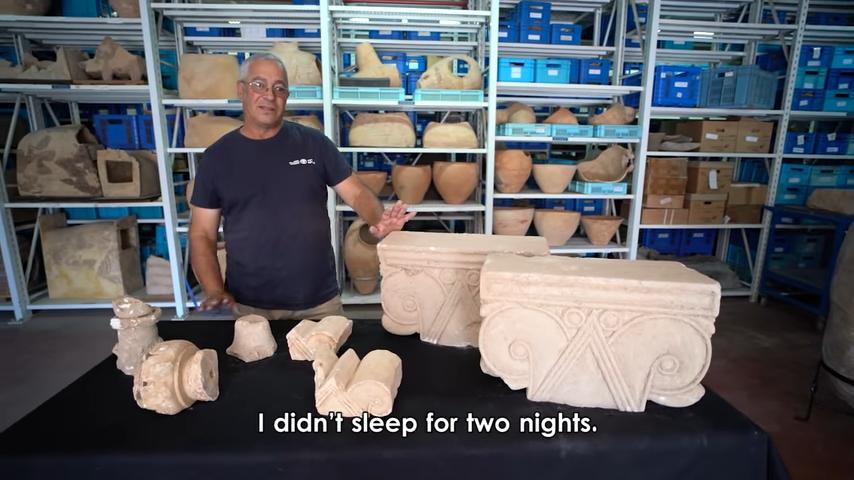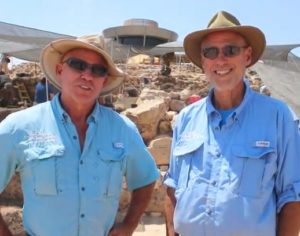Stone Capitals From a ‘Royal Estate’ During First Temple Period Unearthed in Israel
 JERUSALEM — Stone capitals and window frames from a “royal estate” dating sometime between the reign of King Hezekiah and King Josiah (600-700 B.C.) were recently unearthed during an excavation on the Armon Hanatziv (Commissioner’s Palace) Promenade, south of Old City Jerusalem.
JERUSALEM — Stone capitals and window frames from a “royal estate” dating sometime between the reign of King Hezekiah and King Josiah (600-700 B.C.) were recently unearthed during an excavation on the Armon Hanatziv (Commissioner’s Palace) Promenade, south of Old City Jerusalem.
“A rare, impressive, and very special collection of several dozen adorned architectural stone artifacts, which together were part of a magnificent structure, was discovered in the Antiquities Authority’s excavations in preparation for the establishment of a visitor center on the promenade,” the Israeli Antiquities Authority announced in a statement.
The various artifacts are made of limestone and have decorating carvings on them, providing evidence that a building of grandeur once stood at the location.
Among the finds are beautiful capitals in the “Proto-Aeolian” architectural style, which according to researchers is “one of the most significant royal building features of the First Temple period.” Two of the three columns were buried directly on top of each other.
“The importance of this artistic motif as a symbol representing the Kingdoms of Judah and Israel led the Bank of Israel to choose it as the image that adorns the five-shekel coin of the State of Israel,” the Antiquities Authority outlined.
Decorative pieces that were believed to adorn palace windows were also discovered at the location.
Excavation Direcor Yaakov Billig outlined that the finds speak to “the restoration of Jerusalem after the Assyrian siege of the city in 701 BC, during the reign of King Hezekiah.”
“This discovery, along with the palace previously uncovered in Ramat Rachel and the administrative center recently uncovered by the Israel Antiquities Authority on the slopes of Arnona, attests to a new revival in the city and a somewhat ‘exit from the walls’ of the First Temple period, after the Assyrian siege,” he said.
“We reveal villas, mansions and government buildings in the area outside the walls of the city. This testifies to the relief felt by the city’s residents and the recovery of Jerusalem’s development after the Assyrian threat was over,” Billig explained.

Christian News Network reached out to the Pennsylvania-based Associates for Biblical Research (ABR) to obtain their take on the find. Dr. Gary Byers, ABR Senior Archaeologist and dean of the College of Archaeology at Trinity Southwest University in Albuquerque, New Mexico, explained that these are not the first capitals to be found dating to the First Temple period.
“Known from important Israelite sites in the north — Dan, Hazor, Megiddo and Samaria — many also come from southern locations within and around Jerusalem,” he advised. “Two come from the City of David, ten from Ramat Rachel south of Jerusalem and a unique one from the Ein Joweizeh water system tunnel five miles south of the Old City — a broken stone column with its attached capital carved from the same stone.”
Byers said that the find is particularly interesting as it is “near the UN headquarters on what is locally known as the Hill of Evil Counsel (traditionally where Judas agreed with the high priests to betray Jesus). Numerous additional broken pieces of smaller proto-aeolic capitals were also found, which suggests this structure might be of a similar nature to the nearby Ramat Rachel palace with its ten capitals.”
He outlined that the concept for the pillars was most likely taken from the Phoenicians/Canaanites, noting that King Hyram of Tyre helped David and Solomon build their palaces and the temple.
Scott Stripling of ABR, who also serves as a professor of Biblical Archaeology and Church History at The Bible Seminary in Katy, Texas, said that the discovery once gain underscores the veracity of the Scriptures.
“The recently discovered proto-aeloic capitals serve as yet another example of verisimilitude between the biblical text and the excavated material culture in Israel. Along with the recently discovered bullae of Hezekiah and Isaiah from the Ophel, we are beginning to see a clear picture of life in Judea in the 8th century B.C.,” he stated.
“The excavations of Kenyon and Eilat Mazar in the City of David both recovered examples of this distinctive type of capital which typifies the Israelite monarchy,” Stripling noted. “Lipshitz also found them at nearby Ramat Rahel. ABR excavated a worn Corinthian capital at Khirbet el-Maqatir, but the state of preservation of these new capitals is breathtaking.”
Become a Christian News Network Supporter…







Comments are closed.